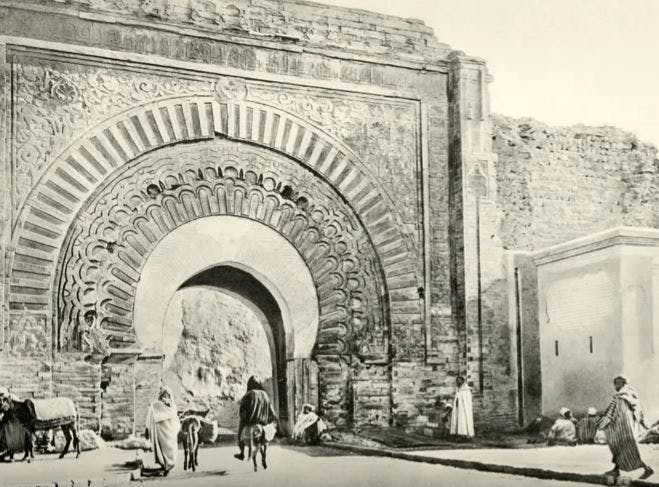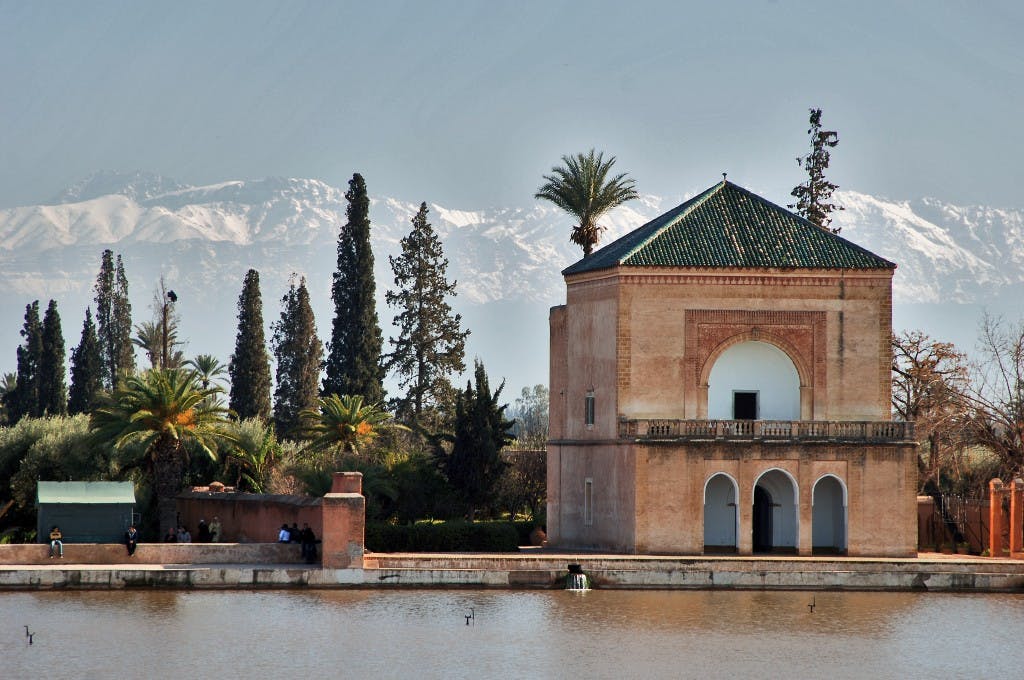Bab Agnaou: Medieval Marvel of the Almohad Dynasty

Bab Agnaou is a monumental gate that is part of the city walls of Marrakech, located in the Kasbah neighborhood within the Medina of Morocco. This heritage site, situated in Marrakech, bears witness to the glorious past of the Berber Almohad dynasty, which established the heart of its power in the city during the 12th century. Their Islamic Caliphate stretched from Cordoba in Andalusia to Tripoli.
1- The Gate of Bab Agnaou in Marrakech

• Bab Agnaou, Gate of Marrakech's Early Period
Bab Agnaou is one of the 19 gates that provide access to the interior of the city walls of Marrakech. This gate ("bab" in Arabic) dates back to the Almohad Berber era in the 12th century. It served as an entrance to the administrative and military complex of the Caliphal Kasbah, the citadel of power, from the south of the city. Flanked by two cannons, it is one of the most impressive gates of Marrakech.the Almoravid Empire
Adorned with elaborate stone decorations, its monumental urban architecture consists of four successive semi-circular arches that appear to be stacked upon each other. This colossal architecture gives Bab Agnaou not only a military role but also a symbolic representation of power. Built from gray-blue Gueliz sandstone, it is sculpted with geometric and floral motifs. A frieze in angular Kufic calligraphy frames the entire gate with verses from the Quran.
• The Name "Bab Agnaou"

The name "Bab Agnaou" has two possible origins. One theory suggests it comes from "gnaoua," referring to the dark-skinned Berber Gnaoua people from the Sahara desert, who entered Marrakech from the south. Another version proposes that Bab Agnaou was originally flanked by two towers, which are now gone. It might have been called the "gate of the hornless ram."
During the Almohad period, the gate was also referred to as "bab el khol" or the "gate of the blacks," and "bab al Qsar," literally the "gate of the palace," referring to the palatial complex of the Caliphal Kasbah.
2- Famous Walls and Gates of Marrakech: Bab Agnaou, Bab Ghmat, Bab Er Robb, Bab Ksiba…
• The Fortification of Marrakech, Starting from 1122
The fortified city walls of Marrakech, with 19 gates, stretch over 19 kilometers and are flanked by 200 watchtowers. Rising 8 to 9 meters high, they reach up to 2 meters in thickness. Constructed from a mixture of clay, lime, and limestone known as "tabia," with a reddish hue, these materials were sourced from the Gueliz hill, where the modern city of Marrakech stands today.
The defensive complex dates back to the very foundation of the Medina of Marrakech. The walls and gates were built starting from 1122 during the Almoravid dynasty, by Ali Ben Youssef, son of Youssef Ibn Tachfin, the first Almoravid caliph and founder of Marrakech in 1071.
The fortified walls were intended to protect against the threat from the Almohad tribes, originating from the High Atlas. During the Almoravid era, Bab Agnaou did not exist, as the Kasbah district at the southern end of the Medina was established during the later Almohad period. At that time, the Marrakech walls were more limited in scope.
The 19 gates, known as "bab" in Arabic, sometimes bear the names of different tribes that engaged in trade or sought protection within the walls. But they have various origins.
For example:
• Bab Aghmat

Bab Aghmat is a gate from the Almoravid era, located at the far southeast of the Marrakech Medina, opening onto the road to Ouarzazate. Its name comes from the city of Aghmat, 32 km from Marrakech, near the Ourika River, in the Berber region. This is where the Almoravids resided before the completion of Marrakech's construction. It was through this gate that the Almohads invaded Marrakech in 1147. Aghmat is the oldest city in Morocco, predating the arrival of Islam, and it remains a significant archaeological site.
• Bab Ksiba

Bab Ksiba is a gate built during the Almohad era. Its southwestern end provides access to the caliphal complex of the Kasbah, the first citadel in Morocco. "Ksiba" means "small fort" in Berber. It is also called Bab El Makhzen, which translates to "gate of the Sultanate."
•Bab Ksiba

Bab er Robb (Ar-Rubb) is also a gate from the Almohad era, located a few meters from Bab Agnaou along the Kasbah neighborhood. It opens to the south, leading toward the Ourika road and the Atlas Mountains. It served as the sole checkpoint for alcoholic beverages. "Robb" is an alcoholic beverage made from figs and raspberries, akin to cooked wine. This gate also witnessed a violent episode. In 1310, during the reign of Sultan Abou Thabit, the decapitated heads of 600 Merinid opponents were displayed as an example.
3- Bab Agnaou, Based on the Remnants of the Almoravid Empire

• Before Bab Agnaou... The Almoravid City
Originating from the western Sahara (present-day Mauritania), the Almoravid Berbers united and capitalized on the trade passing through their territory, from sub-Saharan Africa to western Maghreb. In 1054-1055, they gained control over the gold trade route between Ghana and the Maghreb.
The city of Marrakech was founded in 1071, in the year 463 of the Islamic calendar, by the Almoravid Berber leader Youssef Ben Tachfin, the third emir and first sultan of the dynasty. His mausoleum (unfortunately not well-maintained) is visible near the Koutoubia Mosque.
With an army of 24,000 men, the Almoravids conquered Morocco and Muslim Spain, Al-Andalus, in 1086. Their powerful empire extended from Andalusia in the north to western Algeria in the east, and as far south as Senegal. Marrakech flourished culturally and religiously.
By the end of the 11th century, the khettaras, underground water channels, naturally irrigated Marrakech from the slopes of the Atlas Mountains.
Following his father Youssef Ben Tachfin in 1106, Ali ben Youssef commissioned the construction of numerous mosques, including the one that was initially built where the current Koutoubia stands in 1120, as well as the one adjacent to the former Medersa Ben Youssef, completed between 1121 and 1132.
• The Almoravid Fortifications of Marrakech: Gates & Walls
In 1122-1123, Ali ben Youssef fortified Marrakech by building the initial city walls, fearing the successive advances of the Almohad rebels. While many gates allowed access to the Marrakech Medina, Bab Agnaou had not yet been established. It would become part of the future fortified enclosure of the Caliphal Kasbah to the south of the Medina, constructed during the Almohad period.

4- Bab Agnaou, Architecture Reflecting the Grandeur of the Almohad Caliphate
• The Construction of the Bab Agnaou Gate by the Almohads
Around the same time, circa 1120, the Almohad movement was founded in Tin Mel, located in the High Atlas Mountains (150 km southwest of Marrakech). This religious and military community advocated for a return to a stern and rigid form of Islam. Abd Al Mumin, the first caliph, raised an army for the holy war. He expanded Almohad power by conquering all of North Africa and Andalusia. In 1145, Al-Andalus fell under Almohad rule, and Sevilla became a second capital of the Caliphate. Fes was captured in 1146. In 1147, the Almohads took control of Marrakech, which became their capital, entering through Bab Ghmat in the southeast of the city.
They exterminated and displaced the remaining Almoravids, destroying numerous monuments in the process. However, they preserved the city walls, extending them around the new Caliphal Complex of the Kasbah and creating new gates, such as Bab Agnaou.
• The Almohad Heritage during the Time of Bab Agnaou
Abu Yacoub Yussef, the son of Abd Al Mumin, reigned from 1163 to 1184, and his grandson, Abu Yusef Yaqub Al Mansour (the Victorious), the third caliph, reigned from 1184 to 1199, continuing the Almohad dynasty. They constructed imposing monuments, including the Koutoubia of Marrakech, completed in 1196, the Giralda of Sevilla in 1198, and the incomplete Hassan Tower in Rabat.
The Menara Gardens, as well as the Agdal Gardens, established in 1156, date back to the Almohad era. Located respectively to the south and southwest of the city, they served as reservoirs to irrigate the surrounding olive groves. The gates of Bab Ksiba and Bab Agnaou open in the direction of these gardens.

5- Kasbah Neighborhood, Caliphal Citadel Accessible from Bab Agnaou
• Bab Agnaou, Entrance Gate to the Royal Palace
The Kasbah neighborhood was chosen to house the caliphal residence of Abd Al Mumin, the first caliph of the Almohad dynasty. The palatial complex integrated administrative and military functions of the Caliphate.
Bab Agnaou does not directly face the alley leading to the Kasbah Mosque. Once through the monumental gate, a second wall stands opposite Bab Agnaou. Access to the heart of the Kasbah neighborhood is gained through an offset entrance, designed as a chicane, allowing for a control and reinforcement point. The monumental structure of Bab Agnaou is quite intriguing and is explained by historical context.

• The Mansourian Kasbah
Following Abd Al Mumin, his son Abu Yacoub Yussef, and his grandson Abu Yusef Yaqub Al Mansour continued his work. At the time, Morocco's borders stretched from Tripoli to Cordoba.
Marrakech emerged as a major city in the medieval Muslim west. The Almohad court attracted numerous artists, intellectuals, and writers, reaching its zenith during the rule of Abu Yusef Yaqub Al Mansour. Extensive exchanges between the East, Europe, and the Maghreb developed, including various embassies. This period is referred to as the Mansourian Kasbah era.

The entire "El Mansouria" Kasbah complex included a hospital, where the renowned Andalusian physician Ibn Tufayl practiced. Interestingly, his name is now associated with a major hospital in Marrakech. Averroes, also known by his Arabic name Ibn Rochd of Cordoba, was a prominent philosopher, jurist, and advisor to the third caliph. The mosques of Moulay Al Yazid (of the Kasbah) and Mouassine in Marrakech date back to the reign of Abu Yusef Yaqub Al Mansour.
Bab Agnaou holds the secrets of the Almohad Caliphate, while the remnants of Marrakech's gates and walls continue, nearly a thousand years later, to perpetuate the invaluable legacy left by the powerful Berber Almohad Dynasty.
"Bab Agnaou holds all the secrets of the Almohad Caliphate, but the remnants of the Gates and Ramparts of Marrakech continue, nearly 1000 years later, the invaluable legacy left by the powerful Berber Almohad Dynasty."
the source: https://www.alksar.com/bab-agnaou/
thank you for reading